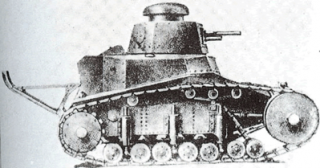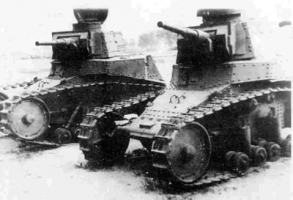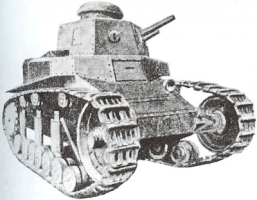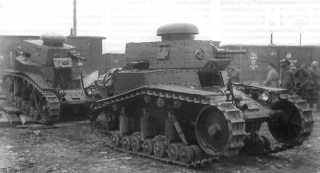MS-1
MS-1 (Stock)
| 0 Koszt |
| 140 PWWytrzymałość |
| 5.35 / 6.5 Masa |
- Dowódca
- Strzelec
- Radiowiec
- Ładowniczy
- Kierowca
| 18/16/16Pancerz kadłuba(przód/boki/tył, mm) |
| 18/16/16Pancerz wieży(przód/boki/tył, mm) |
| 70 KMMoc silnika |
| 32 km/hPrędkość maksymalna/cofania |
| 50 stopni/sPrędkość obrotu |
| 40 damage |
| 34 mmŚrednia penetracja |
| 5.21739130434783 Czas pełnego przeładowania |
| 39 stopni/sPrędkość obrotu działa |
| 200 mZasięg widzenia |
| 500 mZasięg sygnału |
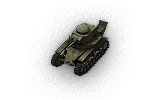
The MS-1 is a Soviet tier 1 light tank.
The first Soviet mass-produced tank, with a total of 959 vehicles manufactured from 1928 through 1931.
It is the smallest and lightest of the tier 1 tanks, and with its tail and hat, possibly the most visually distinctive. It also has a satisfying rumbling "put-put-put" engine sound. When equipped with the 45mm gun it can kill any other tier 1 in around three shots making this tank a very deadly tier 1 to come across. It also has the best penetration of any tier 1.


Wieża
| Poziom | Wieża | Pancerz wieży (przód/boki/tył, mm) | Prędkość obrotu działa (stopni/s) | Zasięg widzenia (m) | Doświadczenie | Masa (t) |
|---|---|---|---|---|---|---|
| I | MS-1 mod. 1927 | 18/16/16 | 39 | 200 | 0 | 170 |
| Poziom | Działo | Średnia penetracja (mm) | Szybkostrzelność | Celność na 100 m | Czas celowania | Doświadczenie | Masa (t) | |
|---|---|---|---|---|---|---|---|---|
| I | 37 mm Hotchkiss | 34/44/9 | 40/40/50 | 11.5 | 0.54 | 2.5 | 0 | 104 |
| Poziom | Wieża | Pancerz wieży (przód/boki/tył, mm) | Prędkość obrotu działa (stopni/s) | Zasięg widzenia (m) | Doświadczenie | Masa (t) |
|---|---|---|---|---|---|---|
| II | MS-1 mod. 1930 | 18/16/16 | 35 | 210 | 170 | 240 |
| Poziom | Działo | Średnia penetracja (mm) | Szybkostrzelność | Celność na 100 m | Czas celowania | Doświadczenie | Masa (t) | |
|---|---|---|---|---|---|---|---|---|
| I | 37 mm B-3 | 40/64/9 | 40/40/50 | 14 | 0.46 | 2.5 | 0 | 77 |
| I | 37 mm Hotchkiss | 34/44/9 | 40/40/50 | 11.5 | 0.54 | 2.5 | 0 | 104 |
| I | 20 mm TNSz | 28/39/9 | 8/8/50 | 76.8 | 0.53 | 1.9 | 0 | 68 |
| II | 23 mm VJa | 30/42/9 | 12/12/50 | 71.05 | 0.54 | 1.9 | 330 | 71 |
| II | 45 mm mod. 1932 | 51/88/12 | 55/55/75 | 11.36 | 0.46 | 2.5 | 150 | 240 |

Silnik
| Poziom | Silnik | Moc silnika (KM) | Prawdopodobieństwo pożaru przy trafieniu | Doświadczenie | Masa (t) |
|---|---|---|---|---|---|
| I | AMO-3 | 70 | 20 | 0 | 920 |

| Poziom | Zawieszenie | Maks. obciążenie | Prędkość obrotu (stopni/s) | Doświadczenie | Masa (t) |
|---|---|---|---|---|---|
| II | T-18 | 6.5 | 50 | 0 | 1200 |

Radio
| Poziom | Radio | Zasięg sygnału (m) | Doświadczenie | Masa (t) |
|---|---|---|---|---|
| I | Alarm_flags_USSR | 500 | 0 | 1 |
Compatible Equipment
Compatible Consumables
Player Opinion
Pros and Cons
Pros:
- Good armor (for a Tier 1 tank).
- Powerful and fairly accurate top gun in the 45 mm mod. 1932, with the best penetration of all the Tier 1 tank guns.
- Decent hull traverse and excellent turret traverse speeds.
- Small size and good camouflage values, making it easy to hide and difficult to detect and hit.
Cons:
- Lowest HP of all the Tier 1 tanks.
- Fairly slow.
- Long aim time.
- Poor view range.
Performance
The MS-1 is a very capable Tier 1 tank, and also quite beginner-friendly, making it an excellent starter tank. Stock, it is slower and weaker than the American and German starter tanks, but it has the thickest armor. The frontal armor is almost twice as thick as the T1 Cunningham's (although 18 mm of armor is not going to stop much incoming fire). Against this, the MS-1 has the lowest HP of all the Tier 1 tanks, and cannot take too many hits.
The starting gun, the 37 mm Hotchkiss, is decent enough against other Tier 1 tanks, but is very inaccurate. The 37 mm B-3 is a great improvement, offering superior penetration, damage, and accuracy to the Hotchkiss gun, while the 45 mm mod. 1932 is the probably best single-shot weapon available to any Tier 1 tank. It has the highest damage and penetration for its tier and will have no problem penetrating all but the most heavily armored tanks the MS-1 faces. Sniping with this gun can be very effective. The high damage per shot also makes it excellent for taking "snap shots" while playing "peek-a-boom" (moving out of cover, taking a quick shot at close range, then moving into cover again). Be mindful that all three single-shot guns have very long aim times (2.5 s). The MS-1 is not particularly well-suited to the play styles that autocannons demand, especially since it is one of the slower Tier 1 tanks. Despite this, the 20 mm TNSh and 23 mm VYa are still viable if the MS-1 can close the distance.
The MS-1 has the lowest horsepower of all the Tier 1 tanks, and is one of the slowest for its tier. It is decently maneuverable, with fair hull traverse and excellent turret traverse speeds, but can have trouble climbing steep slopes. Combined with the excellent single-shot guns it has access to, this makes the MS-1 well-suited to a more careful and deliberate play style, as opposed to the more aggressive play styles of the Leichttraktor or T1.
The MS-1 is also one of the smallest tanks in the game, making it much more difficult to both detect and hit, compared to the other Tier 1 tanks. With a Camouflage Net, it is nearly invisible until it fires.
Early Research
- The 37 mm B-3 is required to unlock the modernized turret, which in turn unlocks the 45 mm mod. 1932 and T-26.
- Upgrading to the GAZ-M1 engine is very helpful since it is both more powerful and weighs less.
- The T-18 suspension provides a welcome increase in the fairly low load limit.
- The 45 mm mod. 1932 is required to unlock the AT-1 tank destroyer, and is highly recommended.
- The 20 mm TNSh and 23 mm VYa autocannons are not required to unlock anything, and are not necessary except to provide the MS-1 with elite status, or if a more aggressive close combat play style is preferred.
- The AMO-3 engine does not provide much significant benefits over the GAZ-M1, and can be saved for last. It is required to unlock the BT-2.
Historical Info
Development
A "Tank Bureau" was formed in May 1924 for the development of Soviet tanks. A specification was issued for a 3-tonne two-man light tank capable of 7.5 mph (12.1 km/h). It would be protected by 16 mm of armor and equipped with a 37 mm (1.5 in) gun. By 1925 the allowable weight had increased to 5 tonnes.
The tank was designed by Professor V. Zaslavsky at a new Tank Bureau set up under the Central Directorate of Military Industries. The 35-horsepower truck engine (a copy of the Italian FIAT 15 ter) was supplied by the Moscow AMO Factory, and the gun was a modified copy of the French 37 mm Puteaux SA 18 cannon. The sprung suspension which would allow a tank to travel faster over rough ground was the biggest improvement over the Renault. A prototype called the T-16 was tested in June 1927.
The T-16 was deemed a failure, as it had problems with its transmission failing too often and its inability to cross trenches more than 1.5 meters wide. The T-16's maneuverability was only marginally better than that of the Renault. Meanwhile the КБ ОАТ drew up plans for an improved version of the T-16 which was accepted for production in July as the T-18, with the tank additionally noted as an MC-1 ("low maintenance type 1").
It was the first Soviet tank adopted for serial production. 959 vehicles were produced from 1928 through 1931.
Operating History
Service in the forces of the first Soviet tanks did not leave behind a large number of clear combat examples. An experimental company equipped with T-18s took part in defending the Far Eastern Railway against Manchurian forces in 1929. They were removed from service in 1932 and given over to training. Following the German invasion of the Soviet Union a number of MS-1s were given 45 mm (1.8 in) guns and entered service as the T-18M.
Historical Gallery
Sources and External Links
| Light Tanks | |
| Medium Tanks | |
| Heavy Tanks | |
| Tank Destroyers | |
| Self-Propelled Artillery |
| USA | |
| UK | |
| Germany | |
| USSR | |
| China | |
| Japan |
